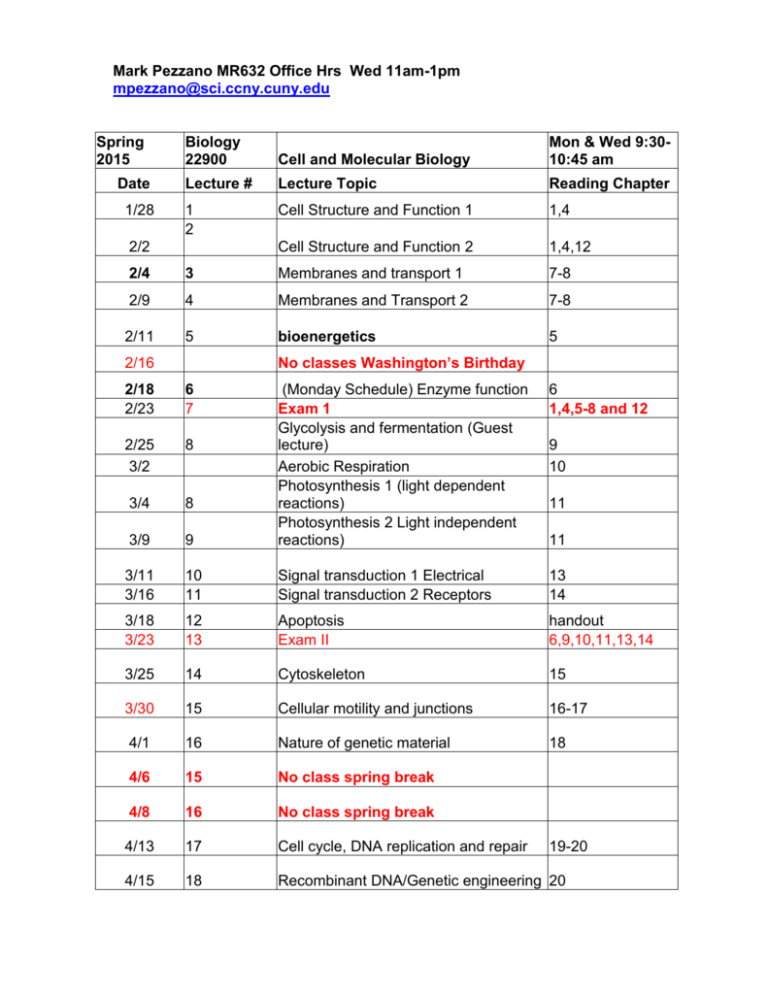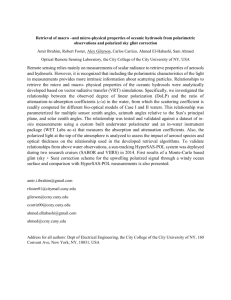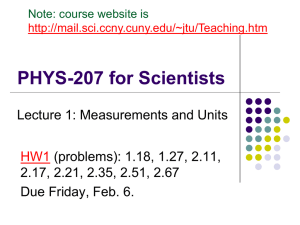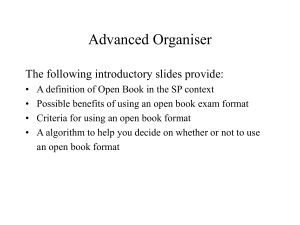Cell and Molecular Biology - The City College of New York
advertisement

Mark Pezzano MR632 Office Hrs Wed 11am-1pm mpezzano@sci.ccny.cuny.edu Spring 2015 Date 1/28 Biology 22900 Cell and Molecular Biology Mon & Wed 9:3010:45 am Lecture # Lecture Topic Reading Chapter 1 2 Cell Structure and Function 1 1,4 Cell Structure and Function 2 1,4,12 2/2 2/4 3 Membranes and transport 1 7-8 2/9 4 Membranes and Transport 2 7-8 2/11 5 bioenergetics 5 No classes Washington’s Birthday 2/16 2/18 2/23 6 7 6 1,4,5-8 and 12 9 (Monday Schedule) Enzyme function Exam 1 Glycolysis and fermentation (Guest lecture) Aerobic Respiration Photosynthesis 1 (light dependent reactions) Photosynthesis 2 Light independent reactions) 2/25 3/2 8 3/4 8 3/9 3/11 3/16 10 11 Signal transduction 1 Electrical Signal transduction 2 Receptors 13 14 3/18 3/23 12 13 Apoptosis Exam II handout 6,9,10,11,13,14 3/25 14 Cytoskeleton 15 3/30 15 Cellular motility and junctions 16-17 4/1 16 Nature of genetic material 18 4/6 15 No class spring break 4/8 16 No class spring break 4/13 17 Cell cycle, DNA replication and repair 4/15 18 Recombinant DNA/Genetic engineering 20 9 10 11 11 19-20 Mark Pezzano MR632 Office Hrs Wed 11am-1pm mpezzano@sci.ccny.cuny.edu 4/20 19 Genetic code 21 4/22 20 Exam 3 15-21 4/27 21 Transcription/RNA processing 21 4/29 22 Translation 22 5/4 23 Regulation of gene expression 1 23 5/6 24 Regulation of gene expression 2 23 5/11 25 Cancer 24 5/13 26 Immunology Handouts (Ch. 21-24 and handouts) 5/18 Final exam week TEXTBOOK: Becker, W., Kleinsmith, L. J., and Hardin, J., The World of the Cell, 8th Ed., Benjamin/Cumming, Pub. LABORATORY MANUAL:LABORATORY MANUAL FOR CELL AND MOLECULAR BIOLOGY, Bio 209 Lectures and exam grades will be posted on blackboard You must read the chapters to be prepared for lecture and succeed in this class. RULES: Absence from more than two laboratory sessions will lead to my submitting a drop card for the student. Students who miss a lab and wish to make it up that week may request permission of the lab instructor of the section they wish to attend. Be careful of lab schedule as holidays sometimes result in different labs being taught in different lab sections so makeups may not be possible. Attendance must be verified by the instructor. Grading for the course will be 50% lecture and 50% lab. The lecture will have 4 exams (no exams will be dropped). The final is mandatory. The lab instructors will be responsible for grading the lecture exams for their sections. I will provide a key and the exams for your lab sections. The syllabus shows the dates of all exams while the lab schedule shows the exam days and paper due dates for lab. For lab there will be a midterm and final covering the labs preceding each exam. Lab exams should be more practical in nature but may also include background material Mark Pezzano MR632 Office Hrs Wed 11am-1pm mpezzano@sci.ccny.cuny.edu from any lab. We will also have 2 lab papers based on the labs. Your lab instructor will discuss the format and content of papers. Course objectives: At the end of the course students should: 1) Know the structure of both prokaryotic and eukaryotic cells and the function of organelles 2) Understand the basic structure and function of enzymes and the relationship between enzymes and cellular metabolism 3) Distinguish photosynthesis and respiration and the location where these processes occur in cells 4) Know the structure of cell membranes and the function of biological membranes in the control of transport 5) Know the signal transduction pathways and mechanisms for cell-to-cell communication 6) Know the stages of the cell cycle and how progression through the cell cycle is controlled at the molecular level 7) Know the central dogma and the processes which control the molecular basis of inheritance 8) Know the structure of a gene and understand its relationship to chromosomes, genetic variation and the genetic basis of inheritance. 9) Understand how gene expression is controlled and how signals at the cell surface result in changes in gene expression. 10) Have a basic understanding of the immune response and the cellular and molecular mechanisms controlling adaptive immunity 11) Understand how nerve impulses are initiated and propagated along neurons 12) Understand the cellular mechanisms used to control apoptosis and the role of programmed cell death in tissue homeostasis 13) Have a basic understanding of how cancer occurs and how it relates to normal cellular control mechanisms 14) Learn basic lab techniques to conduct experiments in cell and molecular biology 15) Design lab experiments with appropriate controls and be able to analyze results and determine the significance of those results with respect to the initial hypothesis tested. 16) Write a lab report describing and analyzing results from your experiments Mark Pezzano MR632 Office Hrs Wed 11am-1pm mpezzano@sci.ccny.cuny.edu CUNY POLICY ON ACADEMIC INTEGRITY Academic Dishonesty is prohibited in The City University of New York and is punishable by penalties, including failing grades, suspension, and expulsion, as provided herein. I. Definitions and Examples of Academic Dishonesty Cheating is the unauthorized use or attempted use of material, information, notes, study aids,devices or communication during an academic exercise. The following are some examples of cheating, but by no means is it an exhaustive list:. • Copying from another student during an examination or allowing another to copy your work. • Unauthorized collaboration on a take home assignment or examination. • Using notes during a closed book examination. • Taking an examination for another student, or asking or allowing another student to take an examination for you. • Changing a graded exam and returning it for more credit. Submitting substantial portions of the same paper to more than one course without consulting with each instructor. • Preparing answers or writing notes in a blue book (exam booklet) before an examination. Allowing others to research and write assigned papers or do assigned projects, including use of commercial term paper services. • Giving assistance to acts of academic misconduct/ dishonesty. • Fabricating data (all or in part). • Submitting someone else’s work as your own. • Unauthorized use during an examination of any electronic devices such as cell phones, palm pilots, computers or other technologies to retrieve or send information. Plagiarism is the act of presenting another person’s ideas, research or writings as your own. The following are some examples of plagiarism, but by no means is it an exhaustive list: • Copying another person’s actual words without the use of quotation marks and footnotes attributing the words to their source.. • Presenting another person’s ideas or theories in your own words without acknowledging the source. • Using information that is not common knowledge without acknowledging the source. • Failing to acknowledge collaborators on homework and laboratory assignments. Internet plagiarism includes submitting downloaded term papers or parts of term papers, paraphrasing or copying information from the internet without citing the source, and “cutting & pasting” from various sources without proper attribution. Obtaining Unfair Advantage is any activity that intentionally or unintentionally gives a student an unfair advantage in his/her academic work over another student. The following are some examples of obtaining an unfair advantage, but by no means it is an exhaustive list: • Stealing, reproducing, circulating or otherwise gaining advance access to examination materials. • Depriving other students of access to library materials by stealing, destroying, defacing, or Mark Pezzano MR632 Office Hrs Wed 11am-1pm mpezzano@sci.ccny.cuny.edu concealing them. • Retaining, using or circulating examination materials which clearly indicate that they should be returned at the end of the exam. • Intentionally obstructing or interfering with another student’s work. Falsification of Records and Official Documents The following are some examples of falsification, but by no means is it an exhaustive list: • Forging signatures of authorization. • Falsifying information on an official academic record. • Falsifying information on an official document such as a grade report, letter of permission, drop/add form, ID card or other college document.








